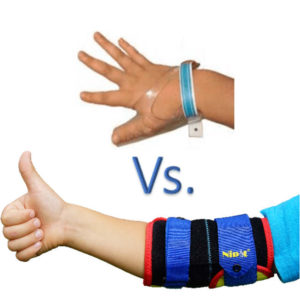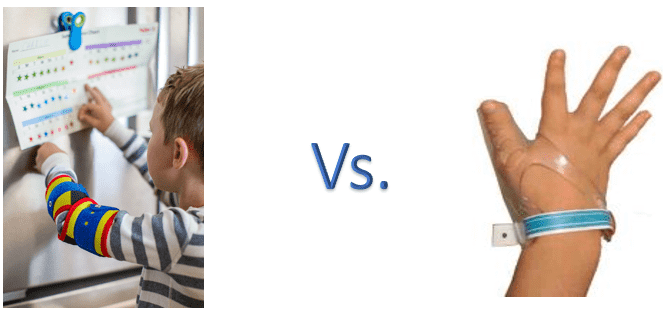
Nipit versus Tguard for Finger Sucking
Parents often feel like they have failed in assisting their thumb sucking kids to quit the habit. It is easy to get confused by the many devices available unless one does a thorough research.
This article will assist in appraising Nipit versus TGuard – their performance and comparison.

How Do The Devices Work?
The main objective of Nipit is to make thumb sucking less attractive by reducing the comfort the kid associates with it. This is by reducing the motion of the hand at the elbow point, so that just when the thumb reaches the mouth a firm pressure is applied to the arm. The Nipit has a hard “stopper” sewn into the fabric acts as a bridge between the forearm and upper arm, and stops the elbow from fully bending.
The Tguard is a plastic device that envelops the thumb. It has some openings that allow air to penetrate through. The air is meant to make suction difficult, thereby, eliminating digit sucking. This product too elimlinates the comfort associated with the habit. In this respect Nipit and Tguard are similar. There are significant differences between the products still and you must chose what is right for your situation.
Start here to become a guru on finger sucking prevention.
Nipit versus Tguard
Detailed below is a comparison of Nipit versus Tguard, products that are known to many parents for successfully fighting thumb sucking or finger sucking.
1. Cost
Compared to Nipit, the initial cost of Tguard is a higher. However, it will usually be much more expensive after two weeks because of the required bracelet replacement. Every time the kid needs to remove the Tguard, to wash his hands, eat, or do many other activities, the bracelet has to be removed with scissors and discarded. When the Tguard is put back on a new bracelet is required. You can image how many bracelets could be needed, but the Tguard Kit only comes with 30. Each replacement pack costs $20 for a set of 50.
If your child does not break the habit within two to three weeks, you will be required to purchase extra bracelets, translating to extra expenditure.
As a result, the net cost of Tguard is usually 80% more costly than the Nipit Hand Stopper.


2. Switching Thumbs
20% of children switch hands when a physical device is used to interrupt the habit. The Tguard is not recommended for a child who switches and needs two, because it makes it too difficult for them to do normal activities while covering both hands, whereas the Nipit can easily be worn on both arms at the same time. The cost of two TGuards plus extra bracelets is about $120, whereas a Nipit two-pack is $70.
3. Ease of Use
Tguard and Nipit both have the best customer reviews, and take different approaches. Its only challenge is constraining the use of the hand by the kid, affecting his normal activities. Sometimes, the plastic part hurts and inflicts blisters on the fingers, causing a lot of discomfort to the kid.
This is not the case with Nipit as the device is put on the elbow and does not limit hands or finger usage. It is made of exceptionally soft and cozy material, and has a sewn-in silicone comfort cushion so that your kid cannot be hurt or feel pain.
4. Effectiveness
Both products have good success rate.
Tguard is one of the most effective products, and much more effective than other methods like the polish and thumb gloves. Its design is very thoughtful and for many is effective. The major downside is that the thumb can slip out and gives the kid the opportunity to resume the digit sucking. The other downside is that kids may transfer their habit of digit or finger sucking to chewing on the silicone thumb guard, so although the sucking habit is broken the oral fixation is not.
Nipit’s major complaint is that kids can still reach the tips of their fingers into their mouth when they push their arm very hard or strain their neck forward; however, Nipit is designed this way on purpose. The child gets tired of doing this after a couple days and “naturally” quits on their own. The psychological benefit of them learning to quit on their own is substantial. The other downside is that older kids (six or older) can remove the gadget on their own, even when the Easylock System is used. But for these older kids, they usually are willing to cooperate and want to stop, so this does not happen too often, especially when they are properly motivated by the parent.
5. Hygiene
This is one feature of any device that most parents are very keen on. Most reviews are about the hygienic conditions of each device. The Nipit squarely beats the Tguard.
The Tguard’s rubber finger cover will accumulate saliva and then dirt which will be sucked by the kid. This is quite unhygienic and makes it quite unpopular compared to Nipit.
On the other hand, Nipit is designed with hygiene in mind; it does not reach the fingers and this makes it easy for the kid to wash hands and maintain cleanliness.
6. Varieties
Tguard has three varieties – the newest Aerothumb, the original “Classic” (costs about $20 less), and the Finger Guard. Each comes in different sizes, and you can select bracelet colors.
Nipit comes in one multi-colored style option, and one size that fits most between the ages of two to seven. To make sure kids love it, the manufacturer has come up with a very colorful design for both boys and girls, and a soft Minkee dot fabric inner lining that is familiar with baby blankets.

Summary
Both Nipit and Tguard are exceptional remedies for digit sucking; with each having its own pros and cons. For the reasons stated, the Nipit Hand Stopper is the top choice recommended by StopThumbSucking.org. Consider both fully, read the reviews, and decide for yourself which is most suitable to your unique situation.
